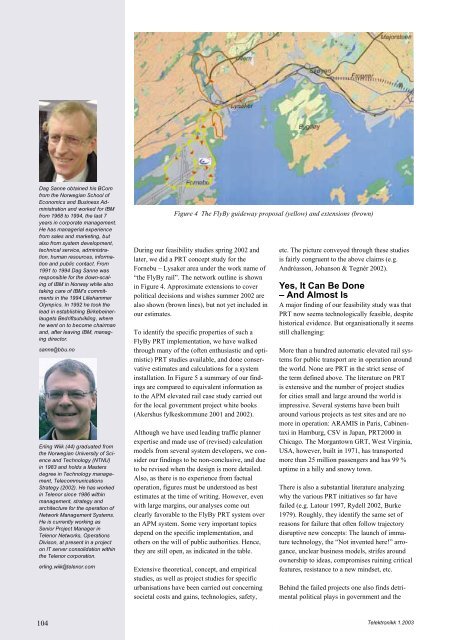Intelligent Transport Systems - Telenor
Intelligent Transport Systems - Telenor
Intelligent Transport Systems - Telenor
Create successful ePaper yourself
Turn your PDF publications into a flip-book with our unique Google optimized e-Paper software.
Dag Sanne obtained his BCom<br />
from the Norwegian School of<br />
Economics and Business Administration<br />
and worked for IBM<br />
from 1968 to 1994, the last 7<br />
years in corporate management.<br />
He has managerial experience<br />
from sales and marketing, but<br />
also from system development,<br />
technical service, administration,<br />
human resources, information<br />
and public contact. From<br />
1991 to 1994 Dag Sanne was<br />
responsible for the down-scaling<br />
of IBM in Norway while also<br />
taking care of IBM’s commitments<br />
in the 1994 Lillehammer<br />
Olympics. In 1992 he took the<br />
lead in establishing Birkebeinerlaugets<br />
Bedriftsutvikling, where<br />
he went on to become chairman<br />
and, after leaving IBM, managing<br />
director.<br />
sanne@bbu.no<br />
Erling Wiik (44) graduated from<br />
the Norwegian University of Science<br />
and Technology (NTNU)<br />
in 1983 and holds a Masters<br />
degree in Technology management,<br />
Telecommunications<br />
Strategy (2002). He has worked<br />
in <strong>Telenor</strong> since 1986 within<br />
management, strategy and<br />
architecture for the operation of<br />
Network Management <strong>Systems</strong>.<br />
He is currently working as<br />
Senior Project Manager in<br />
<strong>Telenor</strong> Networks, Operations<br />
Divison, at present in a project<br />
on IT server consolidation within<br />
the <strong>Telenor</strong> corporation.<br />
erling.wiik@telenor.com<br />
104<br />
Figure 4 The FlyBy guideway proposal (yellow) and extensions (brown)<br />
During our feasibility studies spring 2002 and<br />
later, we did a PRT concept study for the<br />
Fornebu – Lysaker area under the work name of<br />
“the FlyBy rail”. The network outline is shown<br />
in Figure 4. Approximate extensions to cover<br />
political decisions and wishes summer 2002 are<br />
also shown (brown lines), but not yet included in<br />
our estimates.<br />
To identify the specific properties of such a<br />
FlyBy PRT implementation, we have walked<br />
through many of the (often enthusiastic and optimistic)<br />
PRT studies available, and done conservative<br />
estimates and calculations for a system<br />
installation. In Figure 5 a summary of our findings<br />
are compared to equivalent information as<br />
to the APM elevated rail case study carried out<br />
for the local government project white books<br />
(Akershus fylkeskommune 2001 and 2002).<br />
Although we have used leading traffic planner<br />
expertise and made use of (revised) calculation<br />
models from several system developers, we consider<br />
our findings to be non-conclusive, and due<br />
to be revised when the design is more detailed.<br />
Also, as there is no experience from factual<br />
operation, figures must be understood as best<br />
estimates at the time of writing. However, even<br />
with large margins, our analyses come out<br />
clearly favorable to the FlyBy PRT system over<br />
an APM system. Some very important topics<br />
depend on the specific implementation, and<br />
others on the will of public authorities. Hence,<br />
they are still open, as indicated in the table.<br />
Extensive theoretical, concept, and empirical<br />
studies, as well as project studies for specific<br />
urbanisations have been carried out concerning<br />
societal costs and gains, technologies, safety,<br />
etc. The picture conveyed through these studies<br />
is fairly congruent to the above claims (e.g.<br />
Andréasson, Johanson & Tegnér 2002).<br />
Yes, It Can Be Done<br />
– And Almost Is<br />
A major finding of our feasibility study was that<br />
PRT now seems technologically feasible, despite<br />
historical evidence. But organisationally it seems<br />
still challenging:<br />
More than a hundred automatic elevated rail systems<br />
for public transport are in operation around<br />
the world. None are PRT in the strict sense of<br />
the term defined above. The literature on PRT<br />
is extensive and the number of project studies<br />
for cities small and large around the world is<br />
impressive. Several systems have been built<br />
around various projects as test sites and are no<br />
more in operation: ARAMIS in Paris, Cabinentaxi<br />
in Hamburg, CSV in Japan, PRT2000 in<br />
Chicago. The Morgantown GRT, West Virginia,<br />
USA, however, built in 1971, has transported<br />
more than 25 million passengers and has 99 %<br />
uptime in a hilly and snowy town.<br />
There is also a substantial literature analyzing<br />
why the various PRT initiatives so far have<br />
failed (e.g. Latour 1997, Rydell 2002, Burke<br />
1979). Roughly, they identify the same set of<br />
reasons for failure that often follow trajectory<br />
disruptive new concepts: The launch of immature<br />
technology, the “Not invented here!” arrogance,<br />
unclear business models, strifes around<br />
ownership to ideas, compromises ruining critical<br />
features, resistance to a new mindset, etc.<br />
Behind the failed projects one also finds detrimental<br />
political plays in government and the<br />
Telektronikk 1.2003
















